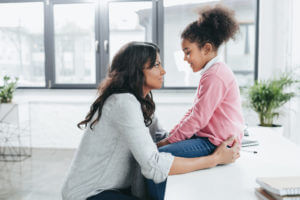10 Mental Health Activities to Do With Your Children
Functional medicine for your children’s mental health is all about providing the tools necessary to navigate life’s daily stressors while balancing the biological chemistry kids need to thrive. Kids are resilient, but only when they have the proper support to get them through.
See how many of these simple mental health activities you can incorporate at home, and watch as you reap the many benefits of improved mental and emotional wellbeing.
Functional Solutions for Holistic Mental Health
The integrative medicine approach to your child’s mental health combines nutritional guidance, supplements, functional diagnostic testing, and behavioral therapy to balance your child’s chemistry with their biological needs and environment.
Integrative medicine for mental health can help your child navigate their strengths and challenges as they develop into an emotionally intelligent, fulfilled, and purpose-driven adult.
Related: Nurturing Holistic Mental Health for Children
These 10 activities are a great place to start with any child to maintain or improve their mental health.
1. Begin With a Gratitude Practice
This activity is incredibly beneficial for children, as well as adults. On paper, list three things that you and your child are grateful for. This activity is often most beneficial first thing in the morning.
Gratitude statements will look different for every child of any age, but the benefit behind this activity is all about shifting perspective.
As humans, some research supports that we’re biologically predisposed to assess fears and risks before we consider the positive aspects (1,2). In primitive times, this was a survival instinct, but in modern life it can make us overly critical and negatively impact the way we make decisions.
Creating a gratitude practice will remind your child he or she can choose those positive thoughts in times of stress and shift perspective toward a more grateful, optimistic attitude.
Experts recommend keeping a gratitude journal, where you can review how your statements have changed over time. And after a while–you’ll have a stockpile of positive gratitudes to review anytime you need to adjust your perspective!
2. Set Intentions
At the beginning of the day (or as close to it as possible) sit down with your kids and have them list 2-3 things that would make today a great day for them.
As with gratitude journaling, these statements will vary based on your child’s age and interests, but the habit is all about creating intention and focusing on it.
With our hyperconnected and overstimulating lives, there are dozens of distractions that vy for your child’s attention from the moment he or she wakes up. Setting a habit to focus their attention facilitates mindfulness and personal responsibility.
Help your kids set intentions by asking questions like:
- What would make you proud today?
- What would you like to build or nurture today?
- What do you want to accomplish today?
- How do you want to treat yourself and others today?
- Is there something you’d like to let go of today?
Examples for younger kids: Today, I will ask questions when I’m confused.
Examples for older kids: Today, I will show myself forgiveness and avoid negative self-talk.
In what ways could setting intentions help your children grow into their best selves?
3. Develop a Nighttime Routine
Few things are as crucial for your child’s mental health and cognition than adequate sleep.
Sleep has been shown to influence elements of mental health including “depression, anxiety, impulsive behavior, and cognitive performance” according to a study in Molecular Psychiatry (3).
In the evening, swap devices that emit blue light (like phones, tablets, or computers) with a book or other activity. Then, develop a nighttime routine that works for you and your child. For some, this is having a bath and applying some calming lavender lotion. For others, this might be adding chamomile essential oil to their diffuser and reading quietly in their room.
Keep bedrooms cool but not cold, quiet, and as neat and tidy as possible. Aim to have your kids stick to a regular bedtime (even on weekends). This promotes a stable circadian  rhythm, or natural sleep cycle.
rhythm, or natural sleep cycle.
4. Challenge Negative Thoughts
Many children and adults are prone to worrying, whether it’s about the future, the past, or just parts of life that aren’t ideal. It’s normal and healthy to have these thoughts, but it’s also beneficial to have a way to challenge them, so they don’t drain your child’s energy, and leave him or her prone to feelings of anxiety or depression.
With practice, you can help your child replace their negative thought patterns. Have your child write down or verbalize worries or concerns he or she has. Then, help them understand how accurate or realistic the thought is.
How likely is it that their worry will occur? If it does, how will they react to it? Would feeling more capable make their worry less scary? Explore alternative outcomes with your child.
5. Nurture Hobbies and Interests
Children and teens develop important goal-setting and confidence in the pursuit of a hobby, sport, or other interest.
Not only does growing a skill in their free time keep their mind active and curious, but it provides a significant boost in self-esteem by showing them how they can improve skills over time and with practice.
Reinforcing your child’s self-esteem will support feelings of individual empowerment and trust in their own abilities when challenges arise.
Encourage your kids to experiment with recreational activities until they find one that suits their interests. Some children gravitate towards sports, others toward knowledge-based activities, and some enjoy creative outlets like painting or writing.
Don’t hesitate to develop shared hobbies with your kids! This shows support and is a great time to bond together.
6. Have a Well-Rounded View of Mental Health
Mental health is heavily influenced by overall health, and this includes physical, nutritional, and emotional health.
Show your kids the benefits of using food as fuel for a healthy body, talk positively about movement and exercise, and set an example by practicing these activities yourself.
Set aside time each day to take breaks outdoors. Children benefit from releasing excess energy in the form of play and physical activity.
For children who have ADHD, increased time spent outside in “green space” has been shown to reduce ADHD symptoms like inattention and impulsivity (4).
7. Help Your Kids Find Their “Tribe”
Kids (and adults) thrive in groups of their peers. When your child has a close-knit group of supportive friends, he or she is more likely to succeed in both academics and social life (5).
Children need a supportive peer group with which to share excitement, concerns, hopes, and dreams. Friendship is an important part of social development, as it fosters empathy and emotional maturity.
8. Journaling
Research–as well as anecdotal evidence–points heavily toward the benefits of journaling for children. Not the least of which are better immune function, reduced stress, and higher test scores (6).
Journaling helps children develop “emotional literacy” or the ability to name and recognize a variety of emotions. Daily journaling might seem like a lot to keep up with in a busy family–and that’s okay. Though it may be sporadic and take encouragement for the first few weeks, journaling is an important part of helping your child with the next section!
9. Take Time to Articulate Feelings
Learning to express feelings helps children build self-awareness and regulate their emotions. Not only does this mean they’ll be better able to communicate their feelings, but they’ll be more likely to approach them from a rational perspective (6).
Often, when children and young adults are feeling challenged, they may lack the ability to communicate how a particular event or action has impacted them. This limitation can lead to tantrums, outburst, and lashing out by kids of all ages.
After a stressful event, help your kids identify and explain how they’re feeling, so they can learn to process big emotions with words, rather than by lashing out.
10. Share Your Own Feelings
Your children see you as a role model for everything, whether you or they realize it or not. Sharing your feelings normalizes dealing with “big” feelings instead of bottling them up.
Instead of hiding big emotions, such as grief or anger, explain to your kids (in as age-appropriate a way as possible) why you’re feeling this way, what happened, and how you’re addressing it today.
Having an example of healthy coping behaviors will follow them long after they reach adulthood.
The Integrative Approach to Mental Wellness
These simple, functional medicine ideas will help you focus on your child’s mental health in ways you can practice in your own home. Making their mental wellbeing a priority, and addressing complex feelings provides coping mechanisms and healthy behaviors they can return to during times of stress now and later in life.
Mental health is inextricably linked with overall health, and a functional approach to mental wellness is important to address the social, emotional, and physical factors that influence your child’s chemistry.
Integrative medicine helps guide you and your child through natural solutions for a better quality of life through optimal mental health and resilience.
Resources
- https://www.psychologytoday.com/us/blog/psych-unseen/202007/how-does-fear-influence-risk-assessment-and-decision-making
- https://onlinelibrary.wiley.com/doi/full/10.1111/j.0272-4332.2004.00433.x
- https://www.ajmc.com/view/how-does-sleep-duration-influence-mental-health-of-children
- https://www.ncbi.nlm.nih.gov/pmc/articles/PMC1448497/
- https://www.ncbi.nlm.nih.gov/pmc/articles/PMC4335644/
- https://www.cambridge.org/core/journals/advances-in-psychiatric-treatment/article/emotional-and-physical-health-benefits-of-expressive-writing/ED2976A61F5DE56B46F07A1CE9EA9F9F

